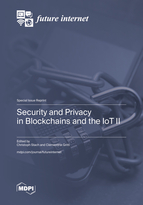Security and Privacy in Blockchains and the IoT II
A special issue of Future Internet (ISSN 1999-5903). This special issue belongs to the section "Internet of Things".
Deadline for manuscript submissions: closed (30 June 2023) | Viewed by 48085
Special Issue Editors
Interests: trustworthy data science and analytics; security techniques for the Internet of Things; secure data management; privacy-aware smart services; privacy-aware big data processing; privacy-aware machine learning
Special Issues, Collections and Topics in MDPI journals
Interests: applied cryptography; data and network security; blockchain technologies; post-quantum cryptography
Special Issues, Collections and Topics in MDPI journals
Special Issue Information
Dear Colleagues,
The Internet of Things and blockchain systems are enabling technologies for a wide range of innovative application, the so-called smart services. For such services, it is essential to collect large amounts of data, link and enrich them, and then make them available for processing. Since smart services are also used in critical infrastructures that handle sensitive data, special attention must be paid to security aspects. For instance, authenticity and veracity must be considered when acquiring data; confidentiality and integrity must be ensured when distributing and storing data; and privacy requirements must be respected when processing and provisioning data, to name just a few of such relevant security aspects.
Therefore, the aim of the second volume of this Special Issue is to provide a holistic overview of all of these security aspects in the context of the Internet of Things and blockchain systems. This includes research reports on technical or organizational innovations, surveys regarding the state of the research, legal or practical opinions on state-of-the-art technologies, as well as experience reports by domain experts. Both in-depth research on individual security aspects relevant to the Internet of Things and blockchain systems, as well as large-scale views on end-to-end data flows from acquisition to provisioning are welcome.
Dr. Christoph Stach
Dr. Clémentine Gritti
Guest Editors
Manuscript Submission Information
Manuscripts should be submitted online at www.mdpi.com by registering and logging in to this website. Once you are registered, click here to go to the submission form. Manuscripts can be submitted until the deadline. All submissions that pass pre-check are peer-reviewed. Accepted papers will be published continuously in the journal (as soon as accepted) and will be listed together on the special issue website. Research articles, review articles as well as short communications are invited. For planned papers, a title and short abstract (about 100 words) can be sent to the Editorial Office for announcement on this website.
Submitted manuscripts should not have been published previously, nor be under consideration for publication elsewhere (except conference proceedings papers). All manuscripts are thoroughly refereed through a single-blind peer-review process. A guide for authors and other relevant information for submission of manuscripts is available on the Instructions for Authors page. Future Internet is an international peer-reviewed open access monthly journal published by MDPI.
Please visit the Instructions for Authors page before submitting a manuscript. The Article Processing Charge (APC) for publication in this open access journal is 1600 CHF (Swiss Francs). Submitted papers should be well formatted and use good English. Authors may use MDPI's English editing service prior to publication or during author revisions.
Keywords
- authentication
- blockchain
- demand-driven data provision
- digital signatures
- distributed ledger technology
- encryption
- Internet of Things
- privacy-aware data processing
- secure data management
- smart things
Related Special Issues
- Security and Privacy in Blockchains and the IoT III in Future Internet (2 articles)
- Security and Privacy in Blockchains and the IoT in Future Internet (9 articles)







